WorldShare Acquisitions Release Notes, August 26, 2021
Release Date: August 26, 2021
Introduction
This release of WorldShare Acquisitions provides 6 new features and enhancements in addition to numerous bug fixes. These features will help you manage more complex workflows, including:
- Sending EDIFACT order messages via secure FTP
- Daily prediction patterns for serials
- Adjusting the price of subscription when renewing items where the target currency does not match the source currency
- Enhanced searching features for Discover Items
- Querying purchase orders via the platform by last update date
- Showing additional title data on invoices
- Allow deletion of funds when used on a completed renewal list
Many of these enhancements are the direct result of your feedback.
Recommended actions
For this release, we recommend that you review the following checklists and complete the relevant tasks so that you can adjust your policies and workflows and train your staff. These checklists identify updates that we have determined as significant for most institutions. We encourage you to review all of the items in the release notes to determine whether there are other items that might require additional action or follow up by your institution.
Administrative actions
These items require immediate action or decisions.
| Action |
|---|
|
If the vendors with which you do EDIFACT ordering prefer transmission of orders via FTP rather than E-mail, you will want to configure FTP sending of orders for these vendors and instruct staff to send orders via FTP (EDIFACT) from now on. |
Follow-up actions
In an effort to keep your staff informed of new features and changes, you may also want to consider these items.
| Action |
|---|
|
If you receive any serial titles that have a daily publication pattern, you may wish to configure this publication pattern for these titles. |
New features and enhancements
Sending EDIFACT order messages via secure FTP
You can now send EDIFACT order messages to your vendor by transferring a file via secure FTP (SFTP or FTPS). This is often the preferred method for vendors to receive EDIFACT order messages and can increase automated processing of orders and thus time to fulfillment. Previously, you could only send EDIFACT order messages via E-mail. Some vendors supported this, but some vendors did not, and most vendors preferred secure FTP as the delivery method for EDIFACT orders. Now, you can send EDIFACT orders directly to vendors using secure FTP protocols in WMS.
To configure your vendor for sending EDIFACT order messages:
- Go to Vendors in the left-hand menu.
- Search for the vendor to which you want to send EDIFACT messages.
- Open the Links and Logins section
- Create a new link with information about the URL, username, password, and directory you want to place EDIFACT order messages:
- Link Name: Name of link (e.g. FTP account for EDIFACT orders)
- Description (optional)
- URL: URL starting with sftp:// or ftps:// to vendor FTP site
- Type: SFTP or FTPS (only secure FTP protocols are allowed, plain text FTP is not allowed)
- User ID: Username provided by the vendor for secure FTP account.
- Password: Password provided by the vendor for secure FTP account.
- Directory: The directory or folder where EDIFACT orders should go.
- No need to specify a beginning slash (e.g. orders not /orders)
- To specify additional folders use a slash however, e.g. incoming/order
-
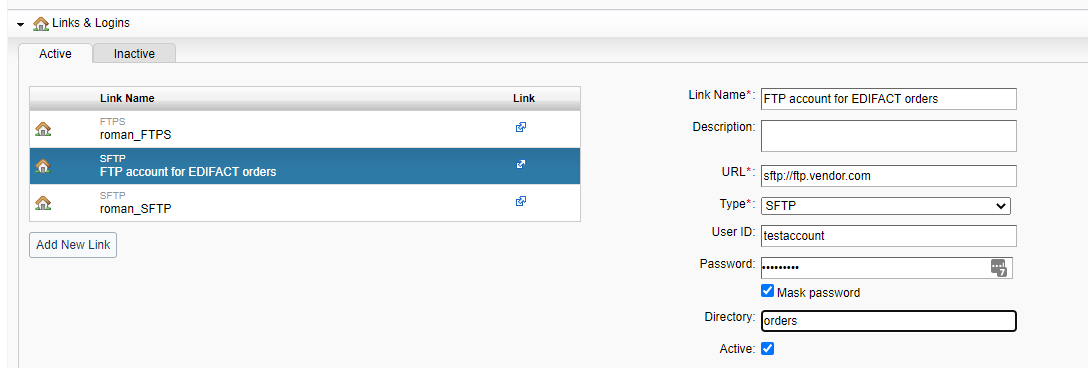
- Save the vendor.
- Open Acquisitions Setting accordion on the vendor page.
- Under Specific Notification Settings, configure the notification settings for ordering:
- Action: Ordering
- Contact: No selection needed.
- Delivery Method: FTP (EDIFACT)
- FTP Profile: The FTP link created in step 4.

- Save the vendor.
To send EDIFACT order messages via FTP:
- Open the order you wish to send to the vendor.
- Click Place Order
- By default, the Notify Vendor of this Order box should be checked. Click Continue.

- On the next page, the default delivery method should be set to FTP (EDIFACT) and the FTP Profile set to the one specified on the vendor page.
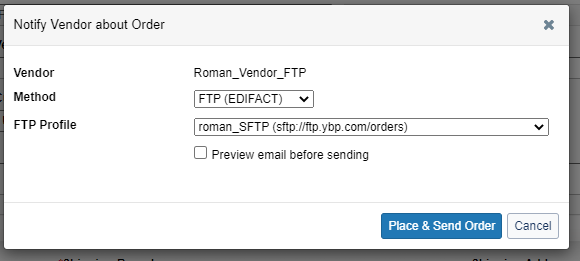
- If you want to preview the EDIFACT order message, click the checkbox and then continue.
- Otherwise, click Place & Send Order.
- The order message will be sent to the specified FTP URL and directory.

Daily prediction pattern for serial titles
You can now configure WMS to predict serial issues using a daily prediction pattern. This means that users no longer have to manually create issues for newspapers and other daily publications for receiving and claiming. Previously, the shortest publication frequency supported was weekly, but now, you can predict issues using a daily publication frequency as well.
To configure a serial with a daily publication pattern:
- Navigate to the serial title in question using Discover Items.
- Click on the title of the serial.
- Open the Manage Issues tab.
- Click Edit next to the words "Not Specified" in the Publication Pattern field.

- Select Daily from the Publication Frequency dropdown menu.

- Configure the enumeration "increments after" and "resets after" values. Note: The default "increments after" and "resets after" are set to 365, but we understand that many titles will not have 365 issues in a volume. Please remember to configure these values as appropriate for this particular publication.

- Save the pattern.
- Now, when you receive the most recent issue of this serial title, the next issue will be created automatically for you.
Adjusting the price of subscription when renewing items where the target currency does not match the source currency
You can now renew items where the source currency does not match the target currency without as much concern that the price will not be accurate. It may not happen often, but it is possible to renew an item where the price on the order or invoice (depending on whether the order price or payment price was selected as the source price) is in a different currency than the target order. For example, an item may be renewed where the invoice for the item is in USD, but the target order for the renewal list is in CAD. In this case, the item is renewed but the renewal list shows the item as "Renewed with Problems" with the Reason 'Target currency does not match source currency." This is done to notify the user that the price being applied is in a different currency than the target order. However, now, while we still do provide this warning for these items, we now adjust the price of these items based on the current exchange rate between the source currency and the target currency. So in other words, if the source price were in USD, and the target order had a currency of CAD, an exchange rate of 1.26 might be applied. The system determines the current exchange rate by first looking in the Exchange Rates table configured by the institution, and then if the specific currency exchange is not available there, it retrieves the current exchange rate from a service used by Acquisitions for this data. This allows the price to be closer to the desired value, based on the currency of the target order; however, it still can be adjusted if it is not as close as desired.
To use this feature, simply renew a renewal list where the source currency of some of the items is different than their target currency. The system will automatically apply the exchange rate to these items as part of the renewal process.
Enhanced searching features for Discover Items
You can now use the enhanced searching features previously available only in Metadata in Discover Items in Acquisitions. This includes 3 specific enhancements:
- Search for items using condensed search results
- View local holding records for my library from search results
- View local holding records for a library in WorldCat Holdings view
These enhancements were available previously in Metadata but are now also available in Discover Items in Acquisitions.
Search for items using condensed search results
To search for items using condensed search results:
- Conduct a search using Discover Items in Acquisitions.
- Click View Condensed Search Results button at the top of the page.

- The search results will be switched to a condensed view. You can switch back to the original view by clicking the View Enhanced Search Results button.

- To add items to an order, a purchase request or a monographic series, click on the Add To button in the Action column.
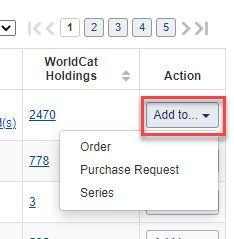
View local holding records for my library from search results
To view local holding records for my library from the search results:
- Search for an item using Discover Items in Acquisitions.
- From the search results, in the 2nd column, there should be a LHR(s) label which has a link to it showing the number of LHRs for the item.

- Click on the link to view the LHRs.
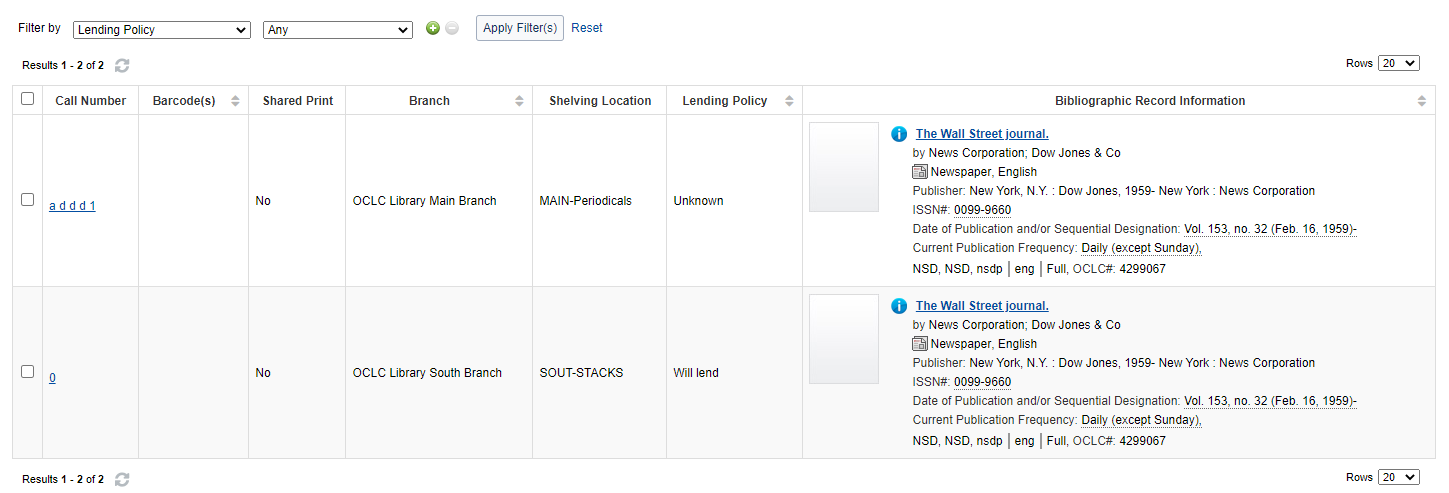
View local holding record(s) for a library in WorldCat Holdings view
To view local holding record(s) for a library in WorldCat Holdings view:
- Search for an item using Discover Items in Acquisitions.
- Click on the Title of the item.
- Click on WorldCat Holdings.
- The WorldCat Holding page will display with 3 tabs.
- Now, the Holding column will contain a link.

- Click the link to view the Local Holding Record(s) for that library.
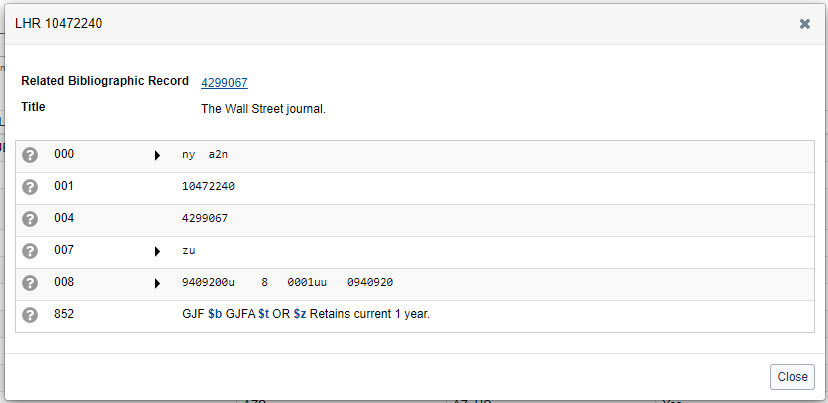
Querying purchase orders via platform by last update date
You can now search for orders on the Platform using the Last Update Date. Previously, you could only query orders by the order status (open or submitted). This meant that libraries wanting to search for their most recent orders had to look through all their submitted orders to find the specific orders they needed. This was time-intensive for the user and resource-intensive for our servers as well. Now, however, you can search for your most recent orders by the Last Update Date. A minimum date is supported as well as a maximum date, so you can perform range searches on the Last Update Date, or you can simply perform a search with a Last Update Date greater than or less than a specific date. The Last Update Date is updated in the following cases:
- Create order
- Update order information (top accordions)
- Add order item
- Update order item pricing
- Delete order item
- Update order exchange rate
- Place purchase order
Showing additional title data on invoices
You can now view additional information from the title of items on invoices. Previously, the title would truncate after two rows with an ellipsis. Now, the title truncates after 4 rows with an ellipsis. You can also still view the full title by hovering your mouse over the title of the item.
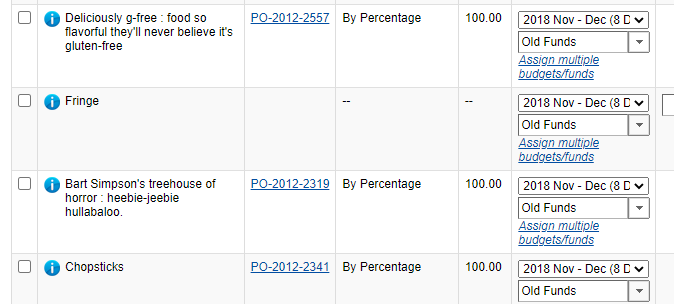
Allow deletion of a fund when used on a completed renewal list
You can now delete a fund that is used on a completed or completed with problems renewal list. Previously, you could not delete a fund on a completed renewal list, even if the list did not result in any open encumbrances or expenditures. Now, you can delete the fund, even if the fund is used on a completed or completed with problems renewal list. The system still does not allow deletion of funds that are used on a new, stopped, or in-progress renewal list.
Bug fixes
Searches in Acquisitions are case insensitive
Searches in Acquisitions are no longer case sensitive. With our last release, in our efforts to switch to a more performant database technology, we inadvertently made some of our searches case-sensitive. Now, all of these searches have been returned to being case insensitive. This includes the autocomplete search used when adding invoice items to an invoice. This now will return both "Taxes" and "TAXES" if the user enters "taxes." Other searches that are no longer case sensitive include:
- Local resources search
- Description
- Order item search
- Fund code
- KB collection identifier
- Receive and invoice search
- Copy number
- Invoice items search
- Fund code
- Payment reference ID
- Invoice item number
- Order item number
Copying budgeted amounts now works when copying a budget structure
You can now copy the budgeted amounts for your funds when copying the fund structure of a budget. Previously, the first time you try to use the "copy budgeted amounts" option when copying a budget structure, it would fail to copy the funds or the budgeted amounts. You would have to try again, in which it would work on the second try. Now, the copy budgeted amounts functionality works on the first try.
Known Issues
Notify vendor checkbox checked when placing orders even if there are no notification settings
Sometimes, when you place an order, the Notify vendor checkbox will be checked even if you have not set any notification settings for ordering for this vendor. To uncheck the notify vendor checkbox, you will need to go to the vendor page under Acquisitions Settings and create a specific notification setting for action Ordering that specifies the delivery method of "Do not send." Alternatively, you can simply unselect the Notify vendor checkbox each time you place an order. This problem should be fixed in the next release.
Important links
Support website(s)
Support information for this product and related products can be found at:
